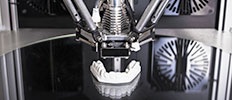In current scenario of the dental industry, there is demand for fast production of highly customized dental products. Since, the 3D printing is a well-established option for faster production of the customized parts, easy to use, highly accurate, and cost effective 3D printing solution are being increasingly preferred over the milling-based methods.
The technology advancements in hardware, materials, and the software are driving the adoption of dental 3D printing & scanning equipment.

How much is the Dental 3D Printing Market worth?
The Global Dental 3D Printing Market is projected to reach USD 5.06 billion by 2023 from an estimated USD 1.78 billion in 2018, at a CAGR of 23.2%. North America projected to grow at the highest CAGR during the forecast period. This is primarily due to the rising incidence of dental caries and tooth loss associated with the aging population, growing Oral Care expenditure, technological advancement, increasing demand of cosmetic energy, and rising popularity of digital dentistry. Asia Pacific region is expected to grow at a higher CAGR during the forecast period.
The report analyzes the global market, by product and service, technology, application, end user, and region. By product and service, the services segment accounted for the largest share of the market in 2017. The large share of this segment can be attributed to the increasing outsourcing done by the small dental clinics, dental hospitals, and dental laboratories to the dental 3D printing service providers.
Based on technology, market is segmented into vat photopolymerization, fused deposition modeling, selective laser sintering, polyjet technology, and other technologies. The vat photopolymerization segment accounted for the largest share of the global market in 2017. The large share can be attributed to the high precision and accuracy of this technique.
Download PDF Brochure @
https://www.marketsandmarkets.com/pdfdownloadNew.asp?id=258228239
By application, the market is divided into prosthodontics, endodontics, and implantology. The prosthodontics segment accounted for the largest share of the market in 2017. The growing edentulous population is one of the major factors driving the growth of this application segment. In addition, the introduction of advanced technologies such as CAD/CAM and the rising adoption of dental 3D printers and scanners have significantly improved prosthetic dentistry procedures. This is a major factor supporting the large share of this application segment.
On the basis of end user, the dental laboratories segment dominated the dental 3D printing market in 2017. The large share of this segment can be attributed to increasing number of dental laboratories, rapid adoption of advanced technologies by dental laboratories across the globe, the increasing outsourcing of certain manufacturing functions to dental laboratories, and rising demand of customized/fabricated dental framing solutions required for various applications.
Which are the key players in the dental 3D printing market and how intense is the competition?
Prominent players in the dental 3D printing market include 3D Systems (US), Stratasys (US/Israel), Renishaw (UK), Roland DG (Japan), SLM Solutions (Germany), EnvisionTEC (Germany), DENTSPLY Sirona (US), Straumann (Switzerland), Formlabs (US), Prodways Group (France), EOS (Germany), Rapid Shape (Germany), DWS (Italy), Planmeca (Finland), Kulzer GmbH (Germany), Ultimaker (Netherlands), Dental Wings (Canada), Carbon (US), and Asiga (Australia).
- In April 2018, EnvisionTEC established a partnership with 3D New Print to enhance its distribution network in France by selling its high-end 3D printers and materials in the French industrial and manufacturing market.
- The Stratasys (US & Israel) launched its J700 Dental 3D Printing System in 2017. Additionally, in order to ensure its future growth, the company adopted strategies such as partnerships, agreements, mergers, and acquisitions to strengthen its product portfolio and customer base and expand its presence across various regions.
Comments
Post a Comment